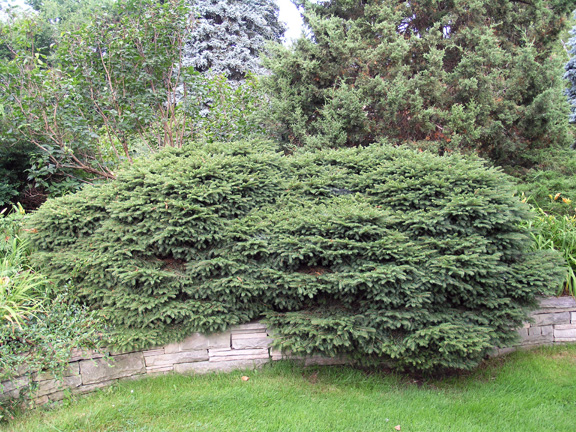
Woody > Picea > Picea abies > Picea abies 'Nidiformis'
Picea abies
'Nidiformis'
Birds Nest Spruce
Origin: Found in Germany in 1904.
Mike's
Opinion


"
This shrub, with its charming shape, is a good choice for adding texture and substance to the garden border. In the summer, it takes a back seat to the colourful perennials, but in winter, the bright green shrub keeps the garden looking alive.
Michael Pascoe, NDP., ODH., CLT., MSc. (Plant Conservation)
"
| Family |
| Pinaceae |
| Genus |
| Picea |
| Species |
| abies |
| Cultivar |
| 'Nidiformis' |
| Category |
| Woody |
| Type |
| Shrub (evergreen) |
| Pronunciation |
| USDA Hardiness Zone |
| 3 - 7 |
| Canadian Hardiness Zone |
| 1b - 8a |
| Temperature (°C) |
| -40 |
| Temperature (°F) |
| -40 |
| Height |
| .95 – 1.95m |
| Spread |
| 1.5 m |
Photographs
Description and Growing Information
Flowering Period
| General Description |
| One of the most popular dwarf conifers. Dense rounded, compact, mounded habit, flat-topped spreading shrub with a depression in the centre. Long lived, highly tolerant of urban pollution and will even thrive in inner city environments. |
| Landscape |
| It can be used for borders, groundcover, as an accent plant, or a foundation plant. This is a relatively low maintenance shrub, and usually looks its best without pruning, although it is tolerant of such. |
| Cultivation |
| Full sun; moderately moist, well-drained soil; extremely hardy. |
| Shape |
| Spreading, dense, broad-rounded globe. |
| Growth |
| Slow |
| ID Characteristic |
| Slow-growing dwarf cultivar, spreading, horizontal to slightly ascending branches form a dense, broad-rounded, shrubby, flattened globe. Mature plants have a depression in the centre of the flattened top, hence the common name of Bird’s Nest Spruce. |
| Pests |
| No serious insect or disease problems. Canker, wood decay, needle cast and rust may occur, it should be monitored for aphids, bagworms and mites |
| Habitat |
| Horticultural origin. |
| Bark/Stem Description |
| Thin when young, scaly with age. |
| Flower/Leaf Bud Description |
| Green to brown. |
| Leaf Description |
| Thin dark, dull grey-green needles up to 2 cm long. Flat, thin and possess sharp, curved hooks on their undersides; a unique characteristic. Crowded on the branch, foliage emerges lime green in spring. |
| Flower Description |
| Monoecious, female flowers are terminal and are pink in colour. |
| Fruit Description |
| Cones, 9–17 cm long, erect or pendulous maturing in first, second, or occasionally third year, dehiscent or occasionally indehiscent, with many spirally arranged ovulate scales and bracts. Not ornamentally significant and quite rare. |
| Colour Description |
| Bright green shoots in spring, but a duller, rich green in winter. |
| Texture Description |
| They relatively fine texture sets it apart from other landscape plants with less refined foliage. |
| Notable Specimens |
| A.M. Cuddy Gardens, Strathroy, Ontario, Canada. The Gardens of Fanshawe College, London, Ontario, Canada. |
| Propagation |
| Large specimens transplant easily, strikes easily from cuttings and grows quite fast when young. |
